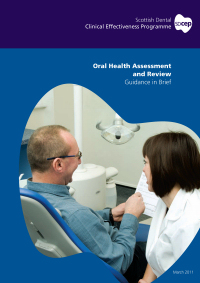
Oral Health Assessment and Review
Published March 2011
Downloads
- Guidance in Brief (PDF)
- Quick Reference Guide (PDF)
- Patient Review and Personal Care Plan (PDF) – an example of a form to help communicate the outcomes of the assessment to the patient
- Assessment Checklist (PDF) – this can be used for both Focussed Oral Health Reviews (FOHRs) and Oral Health Assessments (OHAs) to record which elements of assessment have been conducted and the outcomes of the assessment
- Example Recording Forms to illustrate the information to be gathered as part of oral health assessment and review. An increasing number of dental practices use software with automated data collecting and charting. Therefore, it is not essential that these example forms are used. However, it is recommended that all the information indicated in the example forms is collected using whichever system is most suitable for each dental team. Each example form is designed so that it can be used independently, if appropriate:
- Patient’s Personal Details (PDF)
- Social and Dental History (PDF)
- Medical History (PDF)
- Patient History Update (PDF)
- Dental Anxiety Questionnaire (PDF)
- Assessment of Head and Neck (PDF)
- Assessment of Oral Mucosal Tissue (PDF)
- Assessment of Teeth (PDF)
- Basic Periodontal Examination and Dentition Care Requirements (PDF)
- Radiographic Assessment (PDF)
- Assessment of Dentures (PDF)
All of the above forms are also available in one file (PDF 2.2MB).
These publications are only available as downloadable online resources. They are no longer available in print.
About this guidance
Oral Health Assessment and Review aims to facilitate the move from a restorative approach to patient care to a preventive and long-term approach that is risk-based and meets the specific needs of individual patients. It also aims to encourage the involvement of patients in managing their own oral health. The Guidance in Brief incorporates some important developments including:
- Oral Health Assessments: comprehensive assessments that are only carried out for new patients and then at intervals of 12 months for children or 24 months for adults.
- Focused Oral Health Reviews: interim reassessment of elements of oral health previously identified as of concern, carried out at variable intervals depending on the patient’s risk of future oral disease.
- Applicability: clarification that the approach described is not suited to patients who only attend for urgent care.
- Record keeping: noting those assessment elements that have been completed and recording positive findings.
Some practices will already provide care for many of their patients in a way that reflects the guidance recommendations. However, for others, implementing this approach may represent a significant change to current practice. Therefore it is important to note that:
- adopting this approach is not expected to be immediate, though some aspects could be implemented incrementally;
- the development of complementary practice software will greatly facilitate following the guidance.
The Guidance in Brief refers to a full version (PDF 9.5MB) of the guidance which is now also available. The full version is a more in depth version of the guidance information on which the Guidance in Brief is based and is provided here as a reference for those who require more details. Based on the draft guidance that was available for consultation in 2009, this document has been updated to incorporate important amendments included in the Guidance in Brief in response to consultation feedback. This version includes explanation of the background and general principles of Oral Health Assessment and Review, each element of the assessment and the guidance development process. Please note that this version of the guidance may be subject to further amendments through an ongoing process of review and updating. We welcome feedback to inform future updating.
Guidance development
A Guidance Development Group, comprising individuals from a range of branches of the dental profession, was convened to develop and write this guidance, assisted by our Programme Development Team. Draft guidance was subject to wide consultation and a less detailed Guidance in Brief version was created in response to feedback received, with input from an Advisory Group of representatives of dental primary care. Further information on the SDCEP guidance development process is available.
During the development process, potential barriers to the implementation of this guidance were identified. A Guidance Implementation Summary (PDF)of information about these is provided. For further details visit the TRiaDS website
SDCEP acknowledges the important contribution of all those who commented during the consultation stage.
Review and updating
A review of the context of this guidance (regulations, legislation, trends in working practices and evidence) will take place three years after publication and, if this has changed significantly, the guidance will be updated accordingly.
